| Diese Seite auf Deutsch! |
Sap-sucking Slugs (Sacoglossa) |
 Green leaf slug (Elysia viridis): Schouwen-Duiveland, Netherlands. Photo: Lynn Biscop (iNaturalist). |
Accoring to the systematics of Bouchet et al. (2005), the sap-sucking slugs (Sacoglossa) are divided into three subgroups: The shell-bearing Oxynooidea (about 20% of Sacoglossa) and the shell-less Pleurobranchoidea and finally the Platyhedyloidea.
While in the Oxynooidea the shells of Volvatellidae and Oxynoidae resemble those of bladder snails (Bullidae, Cephalaspidea), on the other hand the Juliidae family is quite interesting, since those are the only snails to possess a bipartite shell.
Class Gastropoda
![]() Subclass
Heterobranchia
Subclass
Heterobranchia
![]()
![]() Infraclass Euthyneura
Infraclass Euthyneura
![]()
![]() Subterclass Tectipleura
Subterclass Tectipleura
![]()
![]() Superorder Sacoglossa
Superorder Sacoglossa
![]()
![]() Superfamily Oxynooidea Stoliczka, 1868 (1847)
Superfamily Oxynooidea Stoliczka, 1868 (1847)
![]()
![]() Family Juliidae E.A. SMITH,
1885
Family Juliidae E.A. SMITH,
1885
![]()
![]() Superfamily Plakobranchoidea J. E. Gray, 1840
Superfamily Plakobranchoidea J. E. Gray, 1840
![]()
![]() Superfamily Platyhedyloidea Salvini-Plawen,
1973
Superfamily Platyhedyloidea Salvini-Plawen,
1973
![]() WoRMS: MolluscaBase eds. (2025):
Sacoglossa.
WoRMS: MolluscaBase eds. (2025):
Sacoglossa.
 "Lettuce Sea Slug" (Elysia crispata) from Dominica Island. Photo: Nick Hobgood (Source). |
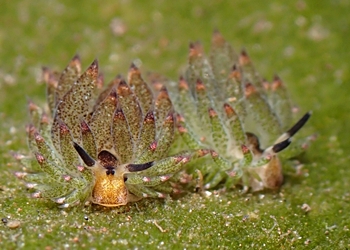 "Leaf-sheep Slugs" (Costasiella kuroshimae) off the Bali coast. Photo: Josy Lai (iNaturalist). |
The distribution of Sacoglossa is largely dependent on where the plants they feed on are found. Most species are present near the equator in the coastal areas of tropical islands. To the north and the south, the species diversity decreases, often species present here are tropical species with a larger temperature tolerance.
In shell-less Sacoglossa scientists were able to prove that all of them posses a shell in their larval stage, which is shed during metamorphosis, the same way as is known from the sea angels (Gymnosomata, Pteropoda) also shell-less in their adult age.
From the earth's history, Sacoglossa are known since the Eocene period (about 34 - 56 mio. years ago, see Geological Timetable). The research of fossil Sacoglossa is difficult, since their shells are so thin-walled and also there is a large amount of erosion in the usual habitat of those gastropods (near the coast). However, considering the presence of algae species they are usually assumed to have feeded on, their presence is probable since the Jurassic or Cretaceous periods.
![]() Ria Tan:
Slugs: nudibranch, sea hare or sap-sucking slug? How to tell them apart.
Ria Tan:
Slugs: nudibranch, sea hare or sap-sucking slug? How to tell them apart.
![]() Ria Tan:
Sap-sucking Slugs (Sacoglossa) of Singapore.
Ria Tan:
Sap-sucking Slugs (Sacoglossa) of Singapore.
 Bosellia mimetica, a sacoglassan gastropod with a very good method of camouflage. |
|
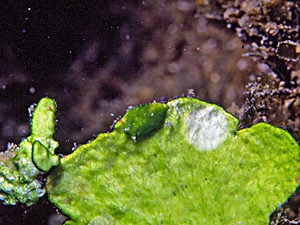 Where is Bosellia mimetica? Photos: Parent Géry (Source). |
![]() Jensen,
K. R. (2006): "Biogeography of the Sacoglossa (Mollusca, Opisthobranchia)".
Bonner zoologische Beiträge 55 (3-4): 255 - 281. 284 valid species of Sacoglossa
are listed.
Jensen,
K. R. (2006): "Biogeography of the Sacoglossa (Mollusca, Opisthobranchia)".
Bonner zoologische Beiträge 55 (3-4): 255 - 281. 284 valid species of Sacoglossa
are listed.
![]() Händeler,
K., Grzymbowski, Y. P., Krug,
P. J.; Wägele, H. (2009): "Functional
chloroplasts in metazoan cells - a unique evolutionary strategy in animal life".
Frontiers in Zoology 6: 28. (Link).
Händeler,
K., Grzymbowski, Y. P., Krug,
P. J.; Wägele, H. (2009): "Functional
chloroplasts in metazoan cells - a unique evolutionary strategy in animal life".
Frontiers in Zoology 6: 28. (Link).
However, algae are not only food to sacoglossans: Similar to many sea hares, sacoglossans also use chemical contents of algae cells to protect themselves against predators.
The use of algae has also been perfected by many sap-sucking slugs as a means of camouflage: Chlorophyll from algae is kept in cells of the slugs' bodies, so the gastropods maintain the colour of their algae-rich environment. Some sacoglossans also maintain a body form similar to their food: For example, Bosellia mimetica (Mimesis means an animal camouflaging as a lifeless object) is hard to tell apart from the algae it feeds on, especially since it oly grows to 8 mm in size.
![]() Bill Rudman:
Bosellia mimetica on
seaslugform.net.
Bill Rudman:
Bosellia mimetica on
seaslugform.net.
|
Kleptoplasty: What is that? Kleptoplasty or Kleptoplastidy is a process, during which e.g. chloroplasts (but also other cellular organells) are acquired by a host organism with its food and subsequently are used to maintain that organism's energy supply.  Costasiella kuroshimae. Photo: Alif Abdul Rahman (Source). This process not only takes place among sap-sucking slugs (Sacoglossa), but also in various other groups, such as foraminiferans, ciliates, as well as other marine slug groups, such as Nudibranchia. |
Among those species there is, for instance the green leaf slug (Elysia viridis) present in the Northeastern Atlantic Ocean, from Norway as far as the Mediterranean Sea, mainly living off algae (Codium fragile), whose chloroplasts it acquires with the plant cells it feeds on. So, with some right those slugs can be referred to as "solar-powered slugs". Another species present on the American West Coast is Elysia chlorotica.
![]() Schnecken mit Solarantrieb.
Schnecken mit Solarantrieb.
![]() WoRMS: MolluscaBase eds. (2025):
Plakobranchidae J.E. GRAY, 1840.
WoRMS: MolluscaBase eds. (2025):
Plakobranchidae J.E. GRAY, 1840.
Leaf sheep slug (Costasiella "kuroshimae", Costasiellidae family), another member of the Sacoglossa group from the Sea of Japan and adjacent regions of the Indopacific. |
Another sacoglossan species lives on green algae with seasonally calcareous cell walls. Since the slug is not capable to destroy the calcareous cell walls, during that time it exclusively survives off its stolen chloroplasts' photosynthesis products.
![]() Film: "The
Lettuce Sea Slug". Quelle:
YouTube.
Film: "The
Lettuce Sea Slug". Quelle:
YouTube.
After the discovery of kleptoplastic Sacoglossans, it had been assumed that the use of chloroplasts by a slug was only possible due to the slug organism also acquiring genetic information from the plant cell (horizontal gene transfer), which would be extremely uncommon between a plant and an animal.
After all, the plant cell's cell core is not available to the slug any longer to regulate the chloroplast's function: So, plants have the ability to regulate the development of harmful substances due to high energy intake (because of strong solar radiation). They achieve this by neutralizing those substances chemically or by enzymes breaking them down into less harmful parts. The gastropod lacks that capability, since it has only the chloroplast available, not the cell core.
Instead, sea slugs regulate "their" chloropasts' function by moving into the shadow (an ability which on the other hand, the plant does not have available), or by using their mantle flaps (parapodia) to cover their body parts containing chloroplasts. Some species also have darker pigments in their skin to protect the chloroplasts.
So far, no evidence could be found for a horizontal gene transfer between plant and gastropod.
![]() Gavagnin,
M.; et al. (1994): "Secondary metabolites from Mediterranean Elysioidea: origin
and biological role". Comparative Biochemistry and Physiology Part B:
Biochemistry and Molecular Biology 108: 107. (Link).
Gavagnin,
M.; et al. (1994): "Secondary metabolites from Mediterranean Elysioidea: origin
and biological role". Comparative Biochemistry and Physiology Part B:
Biochemistry and Molecular Biology 108: 107. (Link).
![]() Rumpho, M. E.; Dastoor,
F. P.; Manhart, J. R.; Lee,
J. (2007): The Kleptoplast. 23. p. 451 (Link).
Rumpho, M. E.; Dastoor,
F. P.; Manhart, J. R.; Lee,
J. (2007): The Kleptoplast. 23. p. 451 (Link).![]() JENSEN, K. R. (1997): "Evolution of the
Sacoglossa (Mollusca, Opisthobranchia) and the ecological associations with
their food plants". Evolutionary Ecology 11: 301–335.
JENSEN, K. R. (1997): "Evolution of the
Sacoglossa (Mollusca, Opisthobranchia) and the ecological associations with
their food plants". Evolutionary Ecology 11: 301–335.
As could be proven by more recent research, many Sacoglossa have a quite astonishing ability to regenerate: In a Japanese laboratory, the kleptoplasty of certain sacoglossan gastropods was supposed to be researched. Instead, the scientists found out that a slug apparently infested with parasites, was able to separate its head from its body and to afterwards regrow the lost body parts.
 Ercolania kencolesi (ca. 5 mm), in (!) Boerge- senia alga. Source: Händeler et al. (2009). |
 Bivalved gastropod (Berthelinia babai): Victoria, Australia. Photo: Rebecca Lloyd (iNaturalist). |
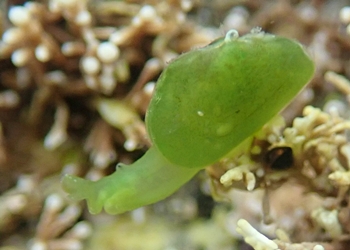 Bivalved gastropod (Berthelinia babai): Victoria. Australia. Photo: Kade (iNaturalist). |
Among the members of the very diverse group of Sacoglossa, there are several which apparently produce doubts about everything supposedly known about gastropods:
A very important rule is that gastropods are distinctly different from bivalves in having a unipartite asymmetrically coiled shell, as opposed to the bipartite, symmetrical shell of mussels and clams.
That is basically correct, except the bivalved gastropod species of the Juliidae family (see photos on the right). However, those only appear to be similar to mussel shells, since only one half of the shell is homologous to the gastropod shell, the other is built secondarily by the gastropod's mantle.
As fossils the bivalved gastropods have often been confounded with real bivalves (and only since 1959 it has been known there are extant species of Juliidae), however living specimens can clearly be identified as gastropods, in spite of their unusual appearance.
![]() WoRMS: MolluscaBase eds. (2025):
Juliidae E.A. SMITH, 1885.
WoRMS: MolluscaBase eds. (2025):
Juliidae E.A. SMITH, 1885.
Latest Change: 24.11.2025 (Robert Nordsieck).